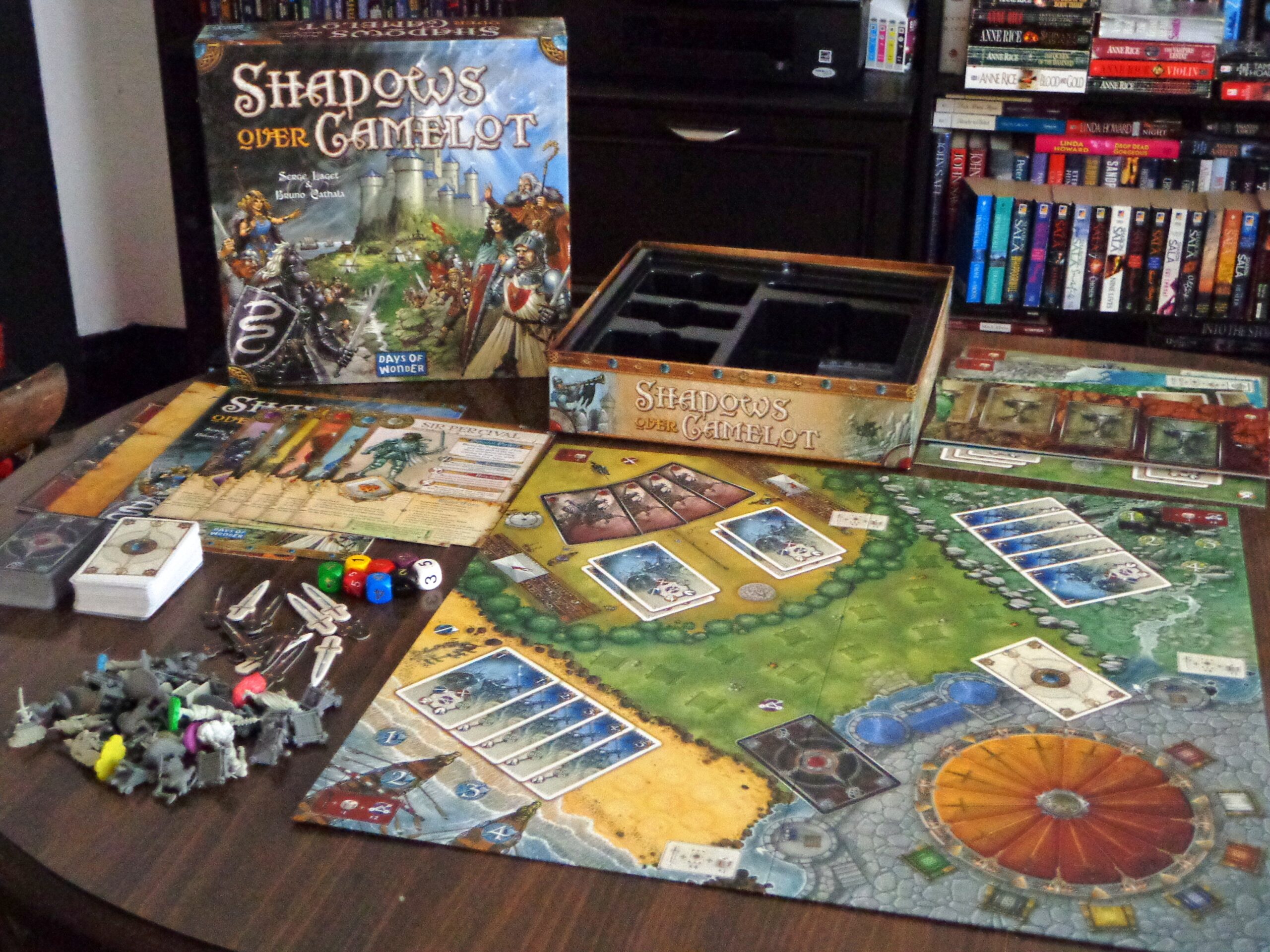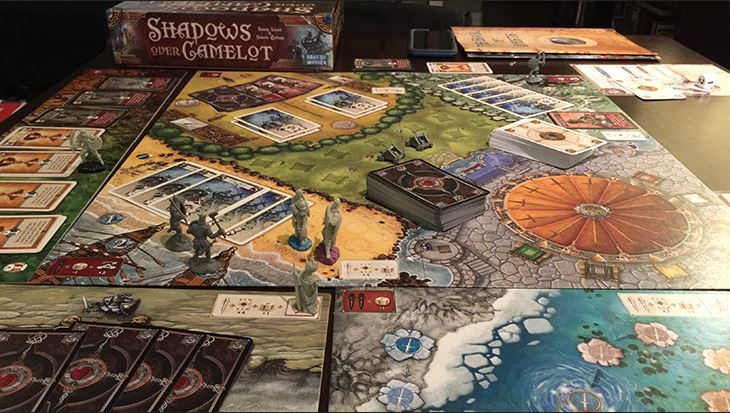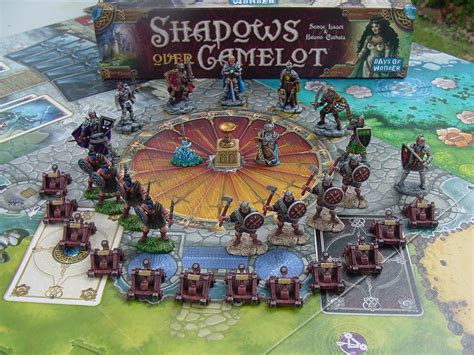As the valiant Knights of the Round Table, players embark on a quest to protect Camelot from the forces of darkness. But here’s the twist in this board game – one among the noble knights may be a traitor secretly working for the game’s ominous antagonist, the Black Knight.
The mystery lies in uncovering the traitor’s identity while completing quests that range from the perilous rescue of Excalibur to the elusive quest for the Holy Grail. Suspicion, deduction, and trust form the game’s core as players must rely on their wits to unmask the traitor before Camelot falls into darkness.
As the knights tackle quests, they must decide who to trust, when to reveal information, and when to challenge their fellow knights. The traitor, cloaked in secrecy, works covertly to thwart the knights’ progress, leaving clues and red herrings along the way. The fate of Camelot hangs in the balance, and the search for the traitor’s identity keeps players on the edge of their seats as they navigate the labyrinthine web of deception and loyalty in Arthur’s legendary court.
What’s included in Shadows over Camelot

- Game board depicting Camelot and surrounding lands.
- Quest cards, including the Holy Grail, the Siege Engine, and others.
- White and black swords representing the progress of good and evil.
- Merlin and Excalibur cards.
- Player pawns representing the knights.
- Allegiance cards (one possible traitor).
- White and black swords indicating the balance of good and evil.
- Travel cards, event cards, and special white cards.
- Siege engines and swords for quests.
How to play Shadows over Camelot

Setup
- Place the game board in the center.
- Shuffle the quest cards and place them face down.
- Shuffle the black and white sword cards separately and place them face down.
- Place the swords of both colors on their respective tracks.
- Each player selects a knight, takes the matching pawn, and places it in Camelot.
- Shuffle the allegiance cards and deal one to each player. Players should secretly view their cards but not reveal them.
- Place the siege engines in the designated locations on the board.
- Place Excalibur and Merlin cards face down next to the board.
- Set up additional components based on the specific quest cards drawn.
Rules for Shadows over Camelot
Shadows over Camelot is played over a series of turns, with each player taking one action in clockwise order. Actions include:
- Quest Actions: Knights can contribute cards to advance quests (e.g., Siege Engines, the Holy Grail). Some quests require specific cards, while others can be fulfilled with any combination of cards.
- Travel: Move to another location on the board.
- Fight an Evil Knight: Discard a set of cards to defeat a Siege Engine.
- Use a Special Ability: Knights can use Excalibur or Merlin’s special abilities.
- Accuse: Knights can publicly accuse a player of being the traitor. This is a high-stakes action and should be done carefully.
- Heal: Knights in Camelot can heal themselves or other knights.
Traitor Mechanic: If a traitor is in the game, they will secretly work against the knights. They can reveal their allegiance at any time during the game to hinder the knights further.
Winning and Losing:
- The knights win by completing a set number of quests (usually seven) before losing by allowing evil to take over or failing to complete quests in time.
- The traitor wins if the knights lose, but only if they have concealed their identity until the end.
Knights you can play as

- King Arthur: The leader of the group, King Arthur provides strategic guidance and can also use his special ability to help other knights on their quests.
- Sir Gawain: Gawain specializes in combating the Saxon and Pict invaders. His special ability allows him to add extra siege engines to the game’s various battles.
- Sir Galahad: Galahad is the Holy Grail knight. He’s essential for the Grail quest, and his special ability allows him to remove siege engines.
- Sir Tristan: Tristan is skilled with ranged combat and excels at battling the Saxons. His special ability lets him hit multiple targets in a single shot.
- Sir Lancelot: Lancelot is a versatile knight and is particularly good at fighting the Black Knight. His special ability allows him to move quickly around the board.
- Sir Percival: Percival is crucial for the Grail quest, as he can pick up Grail cards from other players and move them to the Grail quest. His special ability helps in uncovering hidden traitors.
- Sir Palamedes: Palamedes is a skilled archer who can help in battles and archery contests. His special ability lets him re-roll dice during archery contests.
- Sir Bedivere: Bedivere is adept at fighting the Black Knight and can also contribute to the Holy Grail quest. His special ability lets him exchange cards with other players.
For the official rules, see the link below:
How to win Shadows over Camelot
Succeeding in protecting Camelot as a loyal knight
In “Shadows over Camelot,” playing as a loyal knight is challenging, especially when there may be a traitor among you. Here are some strategies to help non-traitor knights work together and succeed:
- Open Communication: Effective communication is crucial. Share information about the cards you have, the quests you’re working on, and any suspicious activity you observe. Knights should openly discuss their plans and suspicions to maximize their chances of success.
- Quest Prioritization: Prioritize quests based on their difficulty and potential impact. Some quests are more challenging than others, so focus on the ones that are attainable with the cards you have. Keep an eye on the main quest track, as it often indicates the urgency of completing certain quests.
- Special Abilities: Make strategic use of Excalibur and Merlin’s special abilities. Merlin can help you gain valuable information about other players’ allegiance cards, while Excalibur can provide combat advantages when dealing with the Siege Engines.
- Team Up: Collaborate with other knights to achieve quests more efficiently. Combining your efforts can help you complete quests that require multiple knights’ contributions, such as the Holy Grail quest.
- Efficient Card Play: Use your cards wisely. Try to contribute cards to quests when you have multiple cards of the same type or when you’re certain that a quest can be completed. Avoid wasting cards on quests that are unlikely to succeed.
- Balance Good and Evil: Keep an eye on the balance of good and evil on the board. If the balance tips too far toward evil, focus on defeating Siege Engines to restore the balance and prevent the Round Table’s demise.
- Accusing the Traitor: Be cautious when accusing another player of being the traitor. Accusing a loyal knight can damage trust and hinder your efforts. Make sure you have substantial evidence or strong reasons before making an accusation.
- Use Healing Wisely: Knights in Camelot can use their actions to heal themselves or others. Use healing strategically to prevent knights from falling in battle and to maximize your overall efficiency.
- Quest Clues: Pay attention to quest clues. Some quests provide clues that hint at the identity of the traitor. These clues can be valuable in identifying potential threats.
- Don’t Ignore the Siege Engines: While quests are a primary focus, don’t neglect the threat posed by the Siege Engines. These engines can rapidly deplete the good sword cards, making quests harder to complete. Defeating the Siege Engines is essential for maintaining a balance of good and evil.
Remember that working together as a team and maintaining trust among the loyal knights are key to victory in “Shadows over Camelot.” While the presence of a traitor adds complexity to the game, a united front and strategic cooperation can lead to success in protecting Camelot from the shadows.
Leading Camelot to ruin as the traitor (and potentially ruin the fun of the other players too)
Playing as the traitor in “Shadows over Camelot” provides a unique challenge as you must secretly undermine the knights’ efforts while avoiding detection. Here are some strategies to help you succeed as the traitor:
- Blend In: Act like a loyal knight. Make helpful suggestions, contribute cards to quests, and participate in discussions. The longer you go unnoticed, the more damage you can do.
- Timing: Choose the right moments to sabotage quests or the Round Table. Disrupting quests that are close to completion or targeting key objectives can be particularly devastating.
- Subtle Sabotage: Sabotage quests discreetly. Avoid being too obvious in your attempts to thwart the knights’ progress. Use your actions and cards strategically to delay or hinder quests without revealing your true intentions.
- Muddy the Waters: Create confusion and doubt among the loyal knights. Sow seeds of mistrust by making vague or misleading statements, or by suggesting actions that may not be in the knights’ best interest.
- Balance Good and Evil: Pay attention to the balance of good and evil on the board. Pushing it toward evil can create more challenging conditions for the knights and make it easier for you to succeed.
- Accusations and Counteraccusations: If accusations are made against you or another player, remain calm and attempt to redirect suspicion onto others. Counteraccusations can further confuse the situation and divert attention away from you.
- Use the Traitor Deck: Utilize the Traitor Deck if you have it. It allows you to perform additional traitorous actions and can provide opportunities to sabotage quests or advance evil objectives.
- Feign Ignorance: Pretend to be unaware of game mechanics or specific strategies. This can help you appear less threatening and reduce the likelihood of being identified as the traitor.
- Coordinate with the Black Knights: If there are Black Knights in play, coordinate with them to advance the evil objectives. Coordinate your actions to support the Black Knights’ goals without revealing your traitorous nature.
- Timing Your Reveal: Consider when to reveal your identity as the traitor. Revealing too early may lead to an early defeat, while waiting too long can make it difficult to achieve your objectives. Find the right moment to maximize your impact.
Remember that your goal as the traitor is to hinder the knights’ progress without being caught. Deception, misdirection, and subtlety are your allies, and timing is crucial in achieving victory for the forces of darkness in “Shadows over Camelot.”